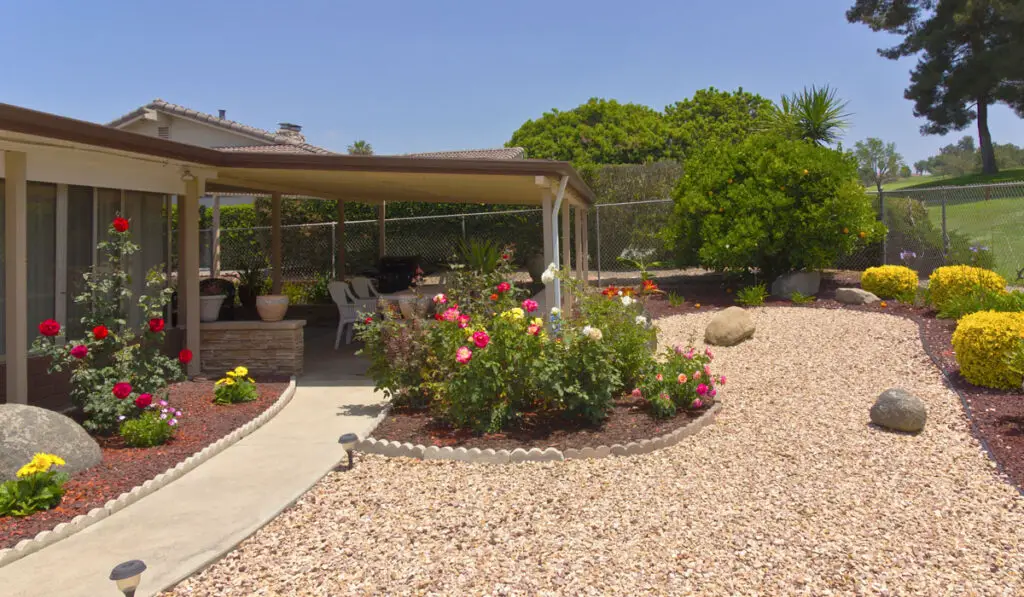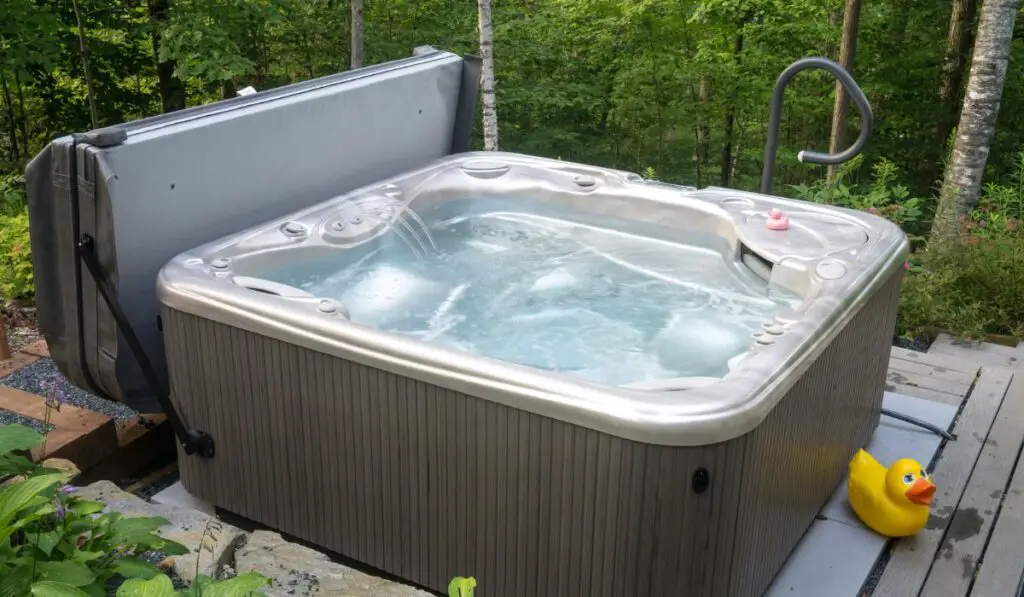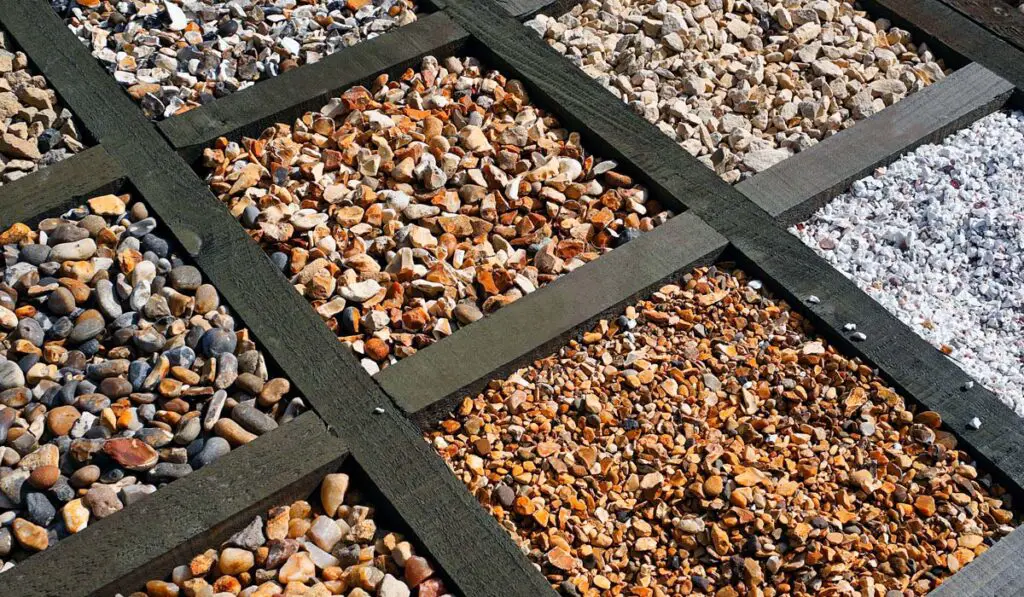Gravel can offer the best base for any hot tub, whether it’s inflatable or acrylic. It can be used on different sites and give several customization options. On top of this, gravel offers many structural benefits compared to other options like concrete pads or decks. So it’s no wonder gravel is one of the most popular bases that hot tub owners use.
Gravel provides good drainage, ease of installation, and leveling and is cost-effective. To install a gravel base, level the ground, remove the topsoil and install the wooden perimeter before adding your choice of gravel: either base gravel, Item #4, crushed stone, or pea.
Gravel comes in many shapes and sizes, from golf ball-sized chunks to small pea gravel. Choosing the type of gravel is just as important as where to create your site. Thankfully, gravel provides a degree of freedom in choosing a location for the hot tub and allows for customization in gravel composition and color.
What Exactly is Gravel?

Gravel is similar to crushed stone in that it comes in small pieces and is uneven in shape and size. The difference is that crushed stone is manufactured while gravel is created naturally.
Generally speaking, gravel has rounded edges and is more circular from years of natural water pressure, making it more ideal for hot tubs regarding inflatable varieties.
That being said, many types of material fall under the heading of gravel, from crushed stone, larger chunks, and small pea-sized gravel. It also comes in different compositions, like limestone. With such variety, it is hard to say precisely what gravel is, other than small pieces of rock.
Can a Hot Tub Sit on Gravel?
Yes, gravel is a fantastic base for your hot tub to sit on. It offers great drainage properties, is aesthetically pleasing, and can be easily installed. In addition, the base can be shaped however you wish and can even make a slope level for your hot tub.
Gravel also offers the benefit of not cracking over time or growing slippery when wet. In addition, it doesn’t shift with the settling weight of a hot tub and, in fact, molds to your hot tub with an even distribution of its size and weight.
Gravel is also cheap, making it ideal for the average homeowner who wishes to purchase a more cost-effective base than other options.
Gravel Base Benefits for Hot Tubs

There are many benefits to placing your hot tub on a gravel base rather than one such as concrete or a wooden deck. From the longevity to the cost, gravel is one of the best bases you can purchase.
Great Support
Gravel hot tub bases are installed in gravel pads. Basically, the square piece your hot tub will sit on. It comes in a 4” thickness and can support an immense amount of weight. It can support as much as a concrete pad that is just as thick, and on top of that, a concrete slab requires gravel underneath it for additional support.
Using gravel as a base for your hot tub also allows the gravel to mold around your spa, making it even more stable. This allows you not to worry about the hot tub becoming unstable or moving over time as the weight settles and shifts with the changing seasons.
Excellent Drainage
Having a base with good drainage is vital to avoid mold and mildew growth underneath the hot tub. You don’t want it just sitting underneath, whether it’s splashed water or rain that accumulates around the hot tub. On the other hand, bases such as concrete don’t offer any drainage at all, which is important to consider in the care of a hot tub.
Having a good draining base also helps prevent slips and falls when stepping in or out of the hot tub since pools of water won’t be stagnant around the bottom of the spa.
Level
When installing a hot tub, you want to be sure it is perfectly level or risk damaging the hot tub shell. Gravel is the easiest way to level it since pavers, and synthetic hot tub pads require an already leveled surface. You can make the area level with gravel without manually digging out dirt or filling in soil.
Cost Effective
A gravel base is the most cost-effective base you can purchase for a hot tub, especially if you are dealing with uneven ground. On average, it will cost about half to a third of a concrete pad and even less than that when installing a deck.
Aesthetically Pleasing
Not only are there practical benefits to using a gravel base, but it also offers an aesthetically pleasing look to the eye. Gravel is attractive and can be shaped to any space, providing optimal customization rather than sticking to a uniform placement with little leeway in layout and location.
Ease of Installation
Gravel offers an easy and quick installation that pavers, concrete, and decks do not. With gravel, there are a few steps that can be completed in a single day while concrete needs to cure for several hours, pavers take time and energy to place, and decks can take weeks to install.
Longevity
The wood tends to rot with decks, more so if it’s constantly wet and under immense pressure. At the same time, concrete can crack over time. On the other hand, gravel can withstand many years of use and won’t crack like concrete or rot like wood. It holds its shape and won’t give with the changing seasons.
What Type of Gravel is Best for a Hot Tub Base

There are many types of gravel, from size to shape and different material makeup. Picking what kind of gravel to use depends on personal preference and several other factors.
Base Gravel
Gravel is rated by its dimension, and most hot tubs tend to use three or more sizes that are put into different layers to create the most solid foundation and allow proper drainage. The most popular option for the bottom layer is rock or stone that ranges from one to two inches in diameter.
Also referred to as clean stone, this gravel is crushed stone created by a machine that makes irregular rock fragments. You don’t want to have an inflatable hot tub on this kind of gravel, as the odd angles and sharp edges can puncture a hole in the side of the spa.
Item #4 Gravel
Item #4 is another popular kind of gravel that utilizes a mixture of machine-crushed stones, dirt, and sand that creates chunks roughly the size of a small ball. Resourcefully, you can also get Recycled Item #4, which has recycled concrete, blacktop, brick, rock, and alternative stones, making it a more environmentally friendly option.
Gray Item #4 is dark gray in appearance, while Quarry Item #4 is crushed limestone. Crushed Bluestone Item #4 is dark blue-gray rocks usually used in municipal paving projects.
With so many different colors and material compositions, Item #4 offers a wide variety of options that can be chosen based on your preferred aesthetic.
Crushed Stone
Crushed stone is the middle type of gravel with golf ball-sized crushed rocks or #57 stone. This type of gravel is created through machines and is very popular in landscaping and construction drains, making it an excellent addition to a gravel hot tub base.
The size and shape of the machine crushed stones offer excellent drainage and prevent the fragments from sticking together and creating a watertight surface.
Pea Gravel
The main difference between pea gravel and the other three types of gravel is the shape. Pea gravel consists of smooth edges that come in more circular shapes, while the other varieties are sharper and less consistent in size.
Pea gravel is a naturally weathered rock smoothed by constant water pressure. This creates a beautiful look that many enjoy under their hot tub and in their landscaping. It can come in many colors and offers a great way to make your backyard unique since it can come in various mixtures.
The downside of pea gravel is that the curved edges don’t lock together like the jagged sides of the other types of gravel. This makes it easier for the gravel to move away from the hot tub base if it is kicked or shifted around by weather, animals, or people. For this reason, pea gravel is used in conjunction with the other varieties of gravel.
How to Install a Gravel Hot Tub Base
A gravel base is one of the easiest to install when setting up your hot tub. You can have the entire base installed within a day with only a few short steps, unlike other options such as concrete or a wooden deck.
Determining the Slope
Since gravel can be used on a slope, it is easier to install. However, you still need to determine the slope to accommodate it, as the hot tub must be leveled effectively.
To do this, you’ll want to measure the site’s highest and lowest points and find the difference. The easiest way is with a laser level (on Amazon).
There are two ways that you can level out a site. The easiest way is by building up the low end, but you can also dig out the high end.
Removing the Topsoil
Before placing any base materials on the ground, you’ll need to remove the top 2” to 4” of topsoil to prevent it from settling and shifting under the hot tub’s weight.
It’s up to your cosmetic preferences on how much topsoil you want to remove after the initial 2”, as the less you take out, the more your hot tub will sit above the ground level. It is also a good idea to tamp down the dirt once the topsoil is removed to prevent the ground from shifting later.
Building a Lumber Perimeter
To frame your gravel pad and prevent the rocks from slipping away, you’ll need to use 4×6 pressure-treated lumber rated for ground contact. When installing this step, you want to ensure that the ground is perfectly level.
Drill through the perimeter lumber and run ½” rebar stakes through the wood and into the ground for the best long-term stability. Next, fasten the corners with 4” exterior screws to hold the perimeter pieces together.
Adding the Stabilization Fabric
Adding a stabilization fabric is entirely optional but highly recommended. The heavy-duty fabric will provide extra support for your hot tub and prevent grass from growing between the stones. Generally speaking, you want a heavy-duty stabilization fabric with a class 3 rating.
Adding the Gravel
Finally, you get to add the gravel. You’ll need at least 4” of gravel across the entire site, leveled off perfectly. After the gravel is spread out and leveled, tamp it down to lock it into place. You can do this by using a power plate compactor or by hand.
To finish the gravel pad, you can add 2” to 3” of pea gravel for cosmetic reasons.
